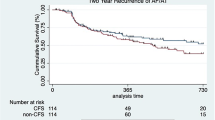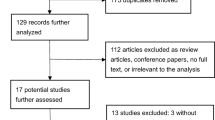Opinion statement
Atrial fibrillation can adversely affect the quality of life for many patients. Though antiarrhythmic drug therapy remains an option for the treatment of atrial fibrillation, the drugs are associated with numerous side effects. Atrial fibrillation ablation has been shown to be as efficacious as antiarrhythmic drug therapy. The field of atrial fibrillation ablations has evolved over time from utilizing radiofrequency energy to using cryoenergy. Newer technologies are being developed with efforts to improve outcomes in patients undergoing atrial fibrillation ablations. This article will highlight two such technologies: cryoballoon ablation catheters and contact force-sensing catheters. These novel catheters appear to be further revolutionizing this young field in electrophysiology.
Similar content being viewed by others
References and Recommended Reading
Papers of particular interest, published recently, have been highlighted as: •• Of major importance
Haïssaguerre M, Jaïs P, Shah D, et al. Spontaneous initiation of atrial fibrillation by ectopic beats originating in the pulmonary veins. N Engl J Med. 1998;339(10):659–66.
Benjamin E, Wolf P, D’Agostino R, Silbershatz H, Kannel W, Levy D. Impact of atrial fibrillation on the risk of death: the Framingham Heart Study. Circulation. 1998;98(10):946–52.
Boriani G, Valzania C, Biffi M, Diemberger I, Ziacchi M, Martignani C. Asymptomatic Lone Atrial Fibrillation - how can we Detect the Arrhythmia? Curr Pharm Des. 2014.
Naccarelli G, Wolbrette D, Khan M, et al. Old and new antiarrhythmic drugs for converting and maintaining sinus rhythm in atrial fibrillation: comparative efficacy and results of trials. Am J Cardiol. 2003;91(6A):15D–26D.
Wazni O, Marrouche N, Martin D, et al. Radiofrequency ablation vs antiarrhythmic drugs as first-line treatment of symptomatic atrial fibrillation: a randomized trial. JAMA. 2005;293(21):2634–40.
Morillo C, Verma A, Connolly S. Radiofrequency ablation vs antiarrhythmic drugs as first-line treatment of paroxysmal atrial fibrillation (RAAFT-2): a randomized trial. JAMA. 2014;311(7):692–700. Radiofrequency ablation has a lower rate of recurrent atrial arrhythmias at 2 years compared to antiarrhythmic drug therapy.
Cosedis Nielsen JJA, Raatikainen P. Radiofrequency ablation as initial therapy in paroxysmal atrial fibrillation. N Engl J Med. 2012;367(17):1587–95.
Pappone C, Oreto G, Rosanio S, et al. Atrial electroanatomic remodeling after circumferential radiofrequency pulmonary vein ablation: efficacy of an anatomic approach in a large cohort of patients with atrial fibrillation. Circulation. 2001;104(21):2539–44.
Cappato R, Calkins H, Chen S, et al. Updated worldwide survey on the methods, efficacy, and safety of catheter ablation for human atrial fibrillation. Circ Arrhythm Electrophysiol. 2010;3(1):32–8.
January C, Wann L, Alpert J, et al. 2014 AHA/ACC/HRS guideline for the management of patients with atrial fibrillation: Executive summary. Journal of the American College of Cardiology. 2014. Guidelines for the management of atrial fibrillation.
Scheinman M, Morady F, Hess D, Gonzalez R. Catheter-induced ablation of the atrioventricular junction to control refractory supraventricular arrhythmias. JAMA. 1982;248(7):851–5.
Gallagher JJ, Svenson RH, Kasell JH, et al. Catheter technique for closed-chest ablation of the atrioventricular conduction system. N Engl J Med. 1982;306(4):194–200. doi:10.1056/NEJM198201283060402.
Fisher J, Brodman R, Kim S, et al. Attempted nonsurgical electrical ablation of accessory pathways via the coronary sinus in the Wolff-Parkinson-White syndrome. J Am Coll Cardiol. 1984;4(4):685–94.
Morady F, Sgheinman MM. Transvenous catheter ablation of a posteroseptal accessory pathway in a patient with the Wolff–Parkinson–White syndrome. N Engl J Med. 1984;310(11):705–7. doi:10.1056/NEJM198403153101108.
Borggrefe M, Budde T, Podczeck A, Breithardt G. High frequency alternating current ablation of an accessory pathway in humans. J Am Coll Cardiol. 1987;10(3):576–82.
Haïssaguerre M, Gencel L, Fischer B, et al. Successful catheter ablation of atrial fibrillation. J Cardiovasc Electrophysiol. 1994;5(12):1045–52.
Calkins H, Reynolds M, Spector P, et al. Treatment of atrial fibrillation with antiarrhythmic drugs or radiofrequency ablation: two systematic literature reviews and meta-analyses. Circ Arrhythm Electrophysiol. 2009;2(4):349–61.
Dagres N, Hindricks G, Kottkamp H, et al. Complications of atrial fibrillation ablation in a high-volume center in 1,000 procedures: still cause for concern? J Cardiovasc Electrophysiol. 2009;20(9):1014–9.
Zhou L, Keane D, Reed G, Ruskin J. Thromboembolic complications of cardiac radiofrequency catheter ablation: a review of the reported incidence, pathogenesis and current research directions. J Cardiovasc Electrophysiol. 1999;10(4):611–20.
Andrade J, Khairy P, Guerra P, et al. Efficacy and safety of cryoballoon ablation for atrial fibrillation: a systematic review of published studies. Heart Rhythm. 2011;8(9):1444–51.
Haines D, Watson D. Tissue heating during radiofrequency catheter ablation: a thermodynamic model and observations in isolated perfused and superfused canine right ventricular free wall. Pacing Clin Electrophysiol. 1989;12(6):962–76.
Haines D, Verow A. Observations on electrode-tissue interface temperature and effect on electrical impedance during radiofrequency ablation of ventricular myocardium. Circulation. 1990;82(3):1034–8.
Khairy P, Chauvet P, Lehmann J, et al. Lower incidence of thrombus formation with cryoenergy versus radiofrequency catheter ablation. Circulation. 2003;107(15):2045–50.
Calkins H, Prystowsky E, Carlson M, Klein L, Saul J, Gillette P. Temperature monitoring during radiofrequency catheter ablation procedures using closed loop control. Atakr Multicenter Investigators Group. Circulation. 1994;90(3):1279–86.
Gallagher J, Sealy W, Anderson R, et al. Cryosurgical ablation of accessory atrioventricular connections: a method for correction of the pre-excitation syndrome. Circulation. 1977;55(3):471–9.
Camm J, Ward D, Spurrell R, Rees G. Cryothermal mapping and cryoablation in the treatment of refractory cardiac arrhythmias. Circulation. 1980;62(1):67–74.
Gillette P, Swindle M, Thompson R, Case C. Transvenous cryoablation of the bundle of his. Pacing Clin Electrophysiol. 1991;14(4):504–10.
Rodriguez L, Leunissen J, Hoekstra A, et al. Transvenous cold mapping and cryoablation of the AV node in dogs: observations of chronic lesions and comparison to those obtained using radiofrequency ablation. J Cardiovasc Electrophysiol. 1998;9(10):1055–61.
Kojodjojo P, Wyn DD. How to perform antral pulmonary venous isolation using the cryoballoon. Heart Rhythm. 2011;8(9):1452–6.
Kojodjojo P, O’Neill M, Lim P, et al. Pulmonary venous isolation by antral ablation with a large cryoballoon for treatment of paroxysmal and persistent atrial fibrillation: medium-term outcomes and non-randomized comparison with pulmonary venous isolation by radiofrequency ablation. Heart. 2010;96(17):1379–84.
Klein G, Gardiwal A, Oswald H. Catheter-based cryoablation of atrial fibrillation: state of the art. Minerva Cardioangiol. 2008;56(6):623–33.
DeVille J, Svinarich J, Dan D. Comparison of resource utilization of pulmonary vein isolation: cryoablation versus RF ablation with three-dimensional mapping in the value PVI study. J Invasive Cardiol. 2014;26(6):268–72. A comparison of cryoballoon ablation versus radiofrequency ablation.
Sarabanda A, Bunch T, Johnson S, et al. Efficacy and safety of circumferential pulmonary vein isolation using a novel cryothermal balloon ablation system. J Am Coll Cardiol. 2005;45(10):1902–12.
Packer D, Kowal R, Wheelan K. Cryoballoon ablation of pulmonary veins for paroxysmal atrial fibrillation: first results of the North American arctic front (STOP AF) pivotal trial. J Am Coll Cardiol. 2013;61(16):1713–23. Study that showed that cryoballoon ablation is safe and effective for the treatment of patients with symptomatic paroxysmal atrial fibrillation.
Bordignon S, Fürnkranz A, Schmidt B, Chun K. Remaining ice cap on second-generation cryoballoon after deflation. Circ Arrhythm Electrophysiol. 2012;5(5).
Linhart M, Bellmann B, Mittmann-Braun E, et al. Comparison of cryoballoon and radiofrequency ablation of pulmonary veins in 40 patients with paroxysmal atrial fibrillation: a case–control study. J Cardiovasc Electrophysiol. 2009;20(12):1343–8.
Xu J, Huang Y, Cai H, et al. Is cryoballoon ablation preferable to radiofrequency ablation for treatment of atrial fibrillation by pulmonary vein isolation? A meta-analysis.. PLoS One. 2014;9(2). Another comparison of cryoballoon ablation versus radiofrequency ablation.
Mandell J, Amico F, Parekh S, Snow J, Germano J, Cohen T. Early experience with the cryoablation balloon procedure for the treatment of atrial fibrillation by an experienced radiofrequency catheter ablation center. J Invasive Cardiol. 2013;25(6):288–92.
Luik A, Merkel M, Hoeren D, Riexinger T, Kieser M, Schmitt C. Rationale and design of the FreezeAF trial: a randomized controlled noninferiority trial comparing isolation of the pulmonary veins with the cryoballoon catheter versus open irrigated radiofrequency ablation in patients with paroxysmal atrial fibrillation. Am Heart J. 2010;159(4):555–60.
Fürnkranz A, Brugada J, Albenque J, et al. Rationale and design of FIRE AND ICE: A multicenter randomized trial comparing efficacy and safety of pulmonary vein isolation using a cryoballoon versus radiofrequency ablation with 3D-reconstruction. J Cardiovasc Electrophysiol. 2014. Future study that will further compare cryoballoon ablation with radiofrequency ablation for the treatment of paroxysmal atrial fibrillation.
Andrade J, Monir G, Pollak S, et al. Pulmonary vein isolation using “contact force” ablation: The effect on dormant conduction and long-term freedom from recurrent atrial fibrillation-A prospective study. Heart Rhythm. 2014. This study illustrates the importance of contact force during atrial fibrillation ablations.
Verma A, Kilicaslan F, Pisano E, et al. Response of atrial fibrillation to pulmonary vein antrum isolation is directly related to resumption and delay of pulmonary vein conduction. Circulation. 2005;112(5):627–35.
Matsuo S, Yamane T, Date T, et al. Reduction of AF recurrence after pulmonary vein isolation by eliminating ATP-induced transient venous re-conduction. J Cardiovasc Electrophysiol. 2007;18(7):704–8.
Yokoyama K, Nakagawa H, Shah D, et al. Novel contact force sensor incorporated in irrigated radiofrequency ablation catheter predicts lesion size and incidence of steam pop and thrombus. Circ Arrhythm Electrophysiol. 2008;1(5):354–62.
Kuck K, Reddy V, Schmidt B. A novel radiofrequency ablation catheter using contact force sensing: Toccata study. Heart Rhythm. 2012;9(1):18–23. A study showing the safety and efficacy of a contact force sensing catheter.
Burkhardt J, Natale A. New technologies in atrial fibrillation ablation. Circulation. 2009;120(15):1533–41.
Okumura Y, Johnson S, Bunch T, Henz B, O’Brien C, Packer D. A systematical analysis of in vivo contact forces on virtual catheter tip/tissue surface contact during cardiac mapping and intervention. J Cardiovasc Electrophysiol. 2008;19(6):632–40.
Stabile G, Solimene F, Calò L. Catheter-tissue contact force for pulmonary veins isolation: a pilot multicentre study on effect on procedure and fluoroscopy time. Europace. 2014;16(3):335–40. A study showing improved procedural and fluoroscopy times when a contact force sensing catheter is used.
Reddy V, Shah D, Kautzner J, et al. The relationship between contact force and clinical outcome during radiofrequency catheter ablation of atrial fibrillation in the TOCCATA study. Heart Rhythm. 2012;9(11):1789–95.
Natale A, Reddy V, Monir G. Paroxysmal AF catheter ablation with a contact force sensing catheter: results of the prospective, multicenter SMART-AF trial. J Am Coll Cardiol. 2014;64(7):647–56. This study illustrates the safety and efficacy of another novel force sensing catheter.
Providência R, Marijon E, Combes S, et al. Higher contact-force values associated with better mid-term outcome of paroxysmal atrial fibrillation ablation using the SmartTouch™ catheter. Europace. 2014.
Marijon E, Fazaa S, Narayanan K, et al. Real-time contact force sensing for pulmonary vein isolation in the setting of paroxysmal atrial fibrillation: Procedural and 1-year results. J Cardiovasc Electrophysiol. 2013.
Jourda F, Providencia R, Marijon E, et al. Contact-force guided radiofrequency vs. second-generation balloon cryotherapy for pulmonary vein isolation in patients with paroxysmal atrial fibrillation-a prospective evaluation. Europace. 2014. A comparison of a contact force-sensing catheter with a cryoballoon ablation catheter.
Compliance with Ethics Guidelines
Conflict of Interest
Dr. Shaun Bhatty and Dr. Anastasios Saliaris each declare no potential conflicts of interest.
Human and Animal Rights and Informed Consent
This article does not contain any studies with human or animal subjects performed by any of the authors.
Author information
Authors and Affiliations
Corresponding author
Additional information
This article is part of the Topical Collection on Arrhythmia
Rights and permissions
About this article
Cite this article
Bhatty, S., Saliaris, A.P. Atrial Fibrillation Ablation in the Era of Cryoballoon and Force-Sensing Catheters: Freeze or Burn?. Curr Treat Options Cardio Med 17, 17 (2015). https://doi.org/10.1007/s11936-015-0374-1
Published:
DOI: https://doi.org/10.1007/s11936-015-0374-1




